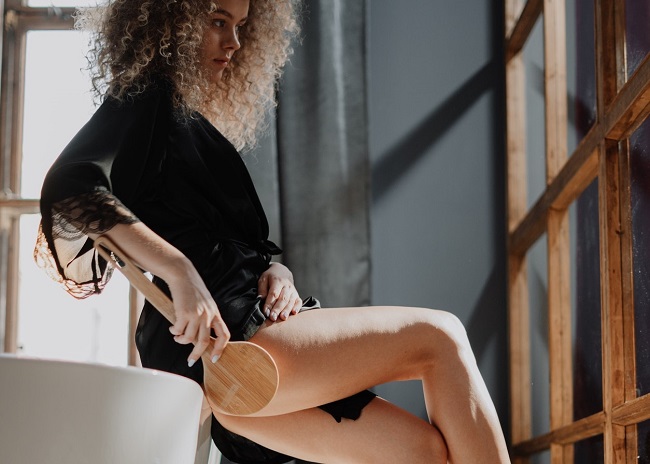Cellulite, or otherwise called orange peel, is a real scourge in women. It can appear on all body types, on different body areas and in various forms. And yes, contrary to what one might think, there is not only one form of cellulite: you can be affected by one of three types of cellulite which result from different causes. This is important since it will determine how to act to treat it effectively. So, what are the different forms of cellulite and what are the solutions to eliminate each of them?
In this section:
What is cellulite?
Cellulite, also known by other names like orange peel, dimpling, or lipodystrophy, is the result of changes in skin structure and a fat accumulation in the adipocytes - the fatty cells of the body - which are located in the hypodermis, namely the deep layer which constitutes the skin.
These fat cells that fill up can also cause:
- poor drainage of the area affected by cellulitis, because the blood and lymphatic vessels passing through the hypodermis are compressed by the fat cells.
- A phenomenon of water retention which causes blood circulation disorders and therefore the increase in cellulite.

Please note: In this article we are talking about fatty and cosmetic cellulite which does not pose any risk to health. Know that there is another type of cellulite: infectious cellulitis, that is, which is caused by the penetration of bacteria under the skin. In these rare cases, it is a serious condition that must be managed in hospital.
The different types of cellulite
It exists three types of cellulite, which result from different causes:
Fat cellulite
Fat cellulite is formed as a result of excess fat storage in adipocytes. This causes swelling of these fat cells and poor drainage of toxins which then create inflammation of the tissues, responsible for bumpy skin. This adipose cellulite is the cause of poor lifestyle, namely sedentary lifestyle and / or poor diet.
It is a soft and painless cellulite. It will most often be localized on the stomach, thighs, hips and buttocks.
To eliminate it you will have to bet on :
- Fat loss. Do physical and sporting activities, eat balanced and fresh, unprepared foods and avoid bad fats (saturated, cooked fats, of animal origin).
- Massage to dislodge dimpling. This thanks to pressure massages of the palpate rolling type or with the help of vibrating apparatus; and by liposuction and therefore by sucking the skin thanks to a suction effect. Do not hesitate to accompany it with an anti-cellulite cream or oil.
Best anti-cellulite cosmetics
Aqueous cellulite
Aqueous cellulite forms as a result of water retention which swells cells, prevents drainage and microcirculation of the blood and lymph, and creates tissue inflammation. The water which stagnates in the body and which is not properly evacuated, creates cellulite and therefore the orange peel. She is favored by a sedentary life and therefore the lack of physical activity. She also has genetic origins.
It is an inconspicuous cellulite, flexible and that you can recognize by the feeling of heavy and swollen leg. This type of cellulite is found in particular in the arms and legs (thighs, calves, hips, knees).
To eliminate it you will have to bet on :
- Drainage techniques. The latter can be done through palpate rolling type massages, preferably performed by a professional or by specific devices. Indeed, the drainage must be powerful, your hands will certainly not be enough to start again a sufficiently effective drainage. There is also anti-cellulite devices able to dislodge aqueous cellulite. They will have to be able to carry out draining massages (suction cup), pressure. They can also be equipped with an infrared heat system and an electric drive.
- Play a sport. To avoid water retention, the solution is to move! To do this, practice a regular sporting activity such as aquabike or swimming. If you are not in physical condition, active walking, practiced for at least 30 minutes a day, is also ideal.
Fibrous cellulite
Fibrous cellulite may be linked to a dysfunction of the collagen fibers which usually fix the cells on the skin and muscles. It is also linked to sagging skin and a long-standing and untreated cellulite. This cellulite is very difficult to get rid of. It manifests itself mainly in the adult woman and more particularly during menopause.
It is a very visible cellulite, hard and painful when you touch it, often of a purplish hue. It is often located in the legs and buttocks.
To eliminate it you will have to bet on :
- The practice of intensive sport. Since it is more difficult to get rid of, it will take all the more effort. Therefore, combine "cardio" sports (aquabike, aquagym, running, swimming, cycling or active walking for the less athletic) with the practice of bodybuilding.
- Have an irreproachable hygiene of life. Avoid foods that are too fatty, too sweet and too salty. In particular, avoid saturated fats and cooked fats. Eat fresh produce, rich in vitamins and trace elements, and unprocessed foods: fruits, vegetables, whole grains, fresh meats and fish. Finally drink at least 1,5l of water per day and avoid tobacco.
- Use massage and drainage techniques. To dislodge fibrous cellulite, you will need to call on the services of health or aesthetic professionals. Many treatments exist and are more or less expensive but have very good results on fibrous cellulite. Less expensive devices have also been designed to reduce fibrous cellulite.
Please note: : These three types of cellulite coexist. Indeed, the causes are closely related and one often favors the other.
The stages of cellulite development
Cellulite has stages of development. At first, you hardly see it: you have to pinch it to let it appear. Then, it settles, becomes more and more visible and more and more difficult to dislodge. This is why it is necessary act from the start to eliminate it or to prevent it from developing. Here is how cellulite evolves over time:
- Young cellulite. Cellulite is emerging and to see it you have to pinch the skin. It is at this stage that it is important to act to eliminate it.
- Cellulite installed. Cellulite is well developed, sometimes even without noticing it. It is apparent even without pinching. You will be able to reduce it but hardly eliminate it.
- Indurated cellulitis. Cellulite has been encrusted for a long time, it is visible regardless of the position. It will be almost impossible to dislodge but it can be mitigated.
Different forms and different stages of cellulite development exist. Water and fat cellulitis are the most common, but if you don't treat them in time, they can set in and be very difficult to dislodge.






